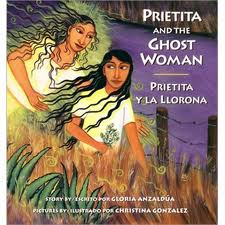La Llorona: Analyzing images of motherhood
Context and rationale
This lesson can be taught in a high beginner or intermediate ESL class. An important reading skill is being able to identify and critically examine images and stereotypes that are embedded in texts. This lesson on was designed specifically for students from Central America with little formal education and supports them in applying this critical reading skill as they read 2 different texts about La Llorona. Many Mexican students and even other Central American students will already be familiar with the story of La Llorona (or a similar story) which will help them in constructing the story as told by the authors and also in examining the different images of motherhood that appear in each text. The grammar objective of the past tense supports students in talking about what happened in the texts and asking questions.
Overview of the lesson This lesson is developed around two different texts about La Llorona, a Mexican folktale with many variations that mostly tell the story of a Mexican woman who kills her children. The first text (see materials for full text) was written by Joe Hayes, an Anglo-American, and is based on the stories of La Llorona he grew up hearing as a child growing up in New Mexico. The second text was written by Gloria Anzaldua, a Chicana writer and literary critic. In contrast to usual depiction of La Llorona as a jealous, vengeful and then repented mother, Anzaludua’s Llorona is a misunderstood but compassionate woman who helps a young girl find an herb to cure her mother. The 2 texts are meant to be read on different days with the following grammar and comprehension activities designed to be integrated around these readings. The readings of the texts are designed to be group readings. Students take turns reading the text out loud in a group reading with the teacher posing questions and queries designed to help students construct the story as told by the author. The final outcome of the lesson will be a discussion and/or short composition where students will explore these images of motherhood.
This lesson is developed around two different texts about La Llorona, a Mexican folktale with many variations that mostly tell the story of a Mexican woman who kills her children. The first text (see materials for full text) was written by Joe Hayes, an Anglo-American, and is based on the stories of La Llorona he grew up hearing as a child growing up in New Mexico. The second text was written by Gloria Anzaldua, a Chicana writer and literary critic. In contrast to usual depiction of La Llorona as a jealous, vengeful and then repented mother, Anzaludua’s Llorona is a misunderstood but compassionate woman who helps a young girl find an herb to cure her mother. The 2 texts are meant to be read on different days with the following grammar and comprehension activities designed to be integrated around these readings. The readings of the texts are designed to be group readings. Students take turns reading the text out loud in a group reading with the teacher posing questions and queries designed to help students construct the story as told by the author. The final outcome of the lesson will be a discussion and/or short composition where students will explore these images of motherhood.
Lesson objective
Students will compare and contrast the ways motherhood is depicted in 2 different texts on the Mexican folktale La Llorona (The Weeping Woman)
Language objectives:
- Students will be able to ask yes/no and wh-questions about the past (using auxiliary verb did) both orally and in writing.
- Students will be able to make statements in the negative about the past (using auxiliary verb did) both orally and in writing
These grammar objectives were chosen because the text is a narrative in the past tense and because many students need more review of negative and questions formation of the simple past.
Lessons and materials
Click on the links below for lesson plan and materials. The attached materials include slightly abridged texts for the students. They also include teacher texts with the same abridged texts, but with embedded questions and queries for the teacher to pose as the students do the out loud readings of the text. The last 2 attachments are handouts that provide simple past practice that is contextualized around the stories.
Anzuldua, Gloria (1996). Prietita and the ghost woman. San Francisco. Children’s Book Press.
Hayes, Joe (2004). La Llorona: The weeping Woman. El Paso. Cinco Juntos Press
click here for an online text of Joe Hayes' La Llorona